
IMAGINE
CASZUIDAS Urban Screen Festival
4 & 5 September 2009, Zuidas, Amsterdam
Compiled by Courtisane for the first edition of CASZUIDAS Urban Screen Festival, Imagine is a selection of works and artists previously shown by Courtisane. Digital reveries and riddles, the video works in this programme seek to actively engage the « mental » participation of urban spectators, to throw them back upon themselves, opening up the limits of their sight to the freedom of their imagination. They imagine a new sensory language in which meaning is played with, but never denied. Between abstraction and playful transformation, distilling, reinterpreting popular media culture, these works leave way for the countless images generated by each spectator. Parallel worlds for the imagination of the spectator to wander around.
curated by Stoffel Debuysere and Maria Palacios Cruz, in cooperation with Courtisane.
Stephen Gray, Beep prepared, 2002, 5’ (UK)
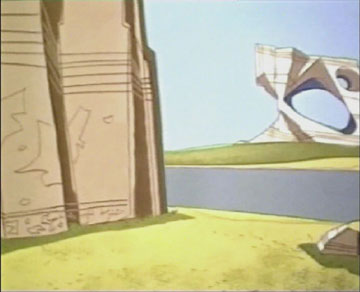
“What is Road Runner without Willie E. Coyote, what is a cartoon without protagonists? What remains of the longest running and most existential series of sketches, once the actors have left the stage? Part one of a deconstructivist trilogy.”
Stephen Gray is a British visual artist. His body of work highlights the growing gulf between the direct and decisive nature of our media conventions and our traumatic, ridiculous and unruly everyday existence. He lives and works in Bristol.
Joseph Ernst, Hip-Hop Movie, 2008, 4’ (UK)

Transforming visual imagery into words, this video is a word for word translation of a stereotypical hip hop video. ‘Bling bling’ from a different point of view.
Joseph Ernst (UK, 1974) studied Architecture at the University of Edinburgh, Sci Arc in Los Angeles, and The Bartlett in London. Since 2000 he has worked as an art director at various advertising agencies in Amsterdam, Shanghai, and London producing work for clients such as Nike, Levis, Electronic Arts, Audi, and Coca Cola. Joseph has been directing since 2007. He currently lives and works in London.
Max Hattler, Collision, 2005, 02’30” (DE/UK)
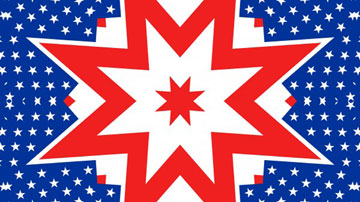
Islamic patterns and American quilts, and the colours and geometry of flags as an abstract field of reflection.
Max Hattler (DE, 1976) graduated from the Royal College of Art with an MA in Animation in 2005 and went on to teach at Goldsmiths College, London and Volda University College, Norway. His films have been broadcast on television and screened at over one hundred film festivals around the world. Max also directs music videos. He lives and works in London and Berlin. Award for Best Experimental Film, Halloween Short Film Festival, London, 2006 Honourable Mention, Darklight Festival, Dublin, 2006 Special Mention, San Gio Festival, Italy, 2006.
David O’Reilly, RGB XYZ, 2005-2008, 13′ (IE)
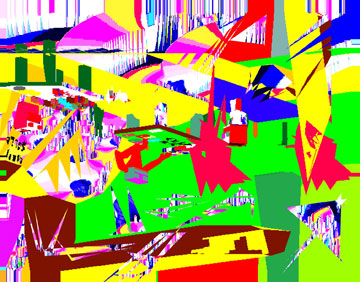
Discovered in late 2007 when a gardener accidentally dug up a hard drive buried somewhere in central Europe, RGB XYZ found its way to David O’Reilly, who compiled its five incomprehensible episodes into what became perhaps the most enigmatic piece of animation ever to leave a computer.
David O’Reilly (IE, 1985) is an animation artist based in Berlin. His unorthodox approach to animation is essentially straight-forward in intention: “I want every idea to justify existing in animation–to be ideas that would be useless in any other medium,” he explains. “Essentially I want to capture elements of life which could never be recorded by camera. If film is ideal for capturing a sense of reality, then animation offers the chance to embrace ideas of perception, which is an entirely different proposition.”
Simon Faithfull, 13, 2004, 5’25” (UK)
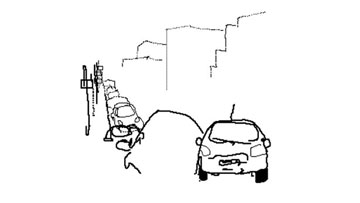
A melancholy journey through a strangely dissolving and pixelated landscape. Created from PalmPilot drawings made while walking along the A13 trunk road, the film presents the journey in the mind of a dog as it sniffs its way back to Barking. A road movie in a parallel universe, populated by ghost lorries in the night and suffused with the pathos of dying light. Sound by Joe Wilson of the Sneaker Pimps.
Simon Faithfull (UK, 1966) is lecturer at the Slade School of Art and lives in Berlin and London. His drawings, videos and installations have been in numerous national and international solo and group exhibitions.
Dave Griffiths, Rogue State, 2003, 02’20” (UK)
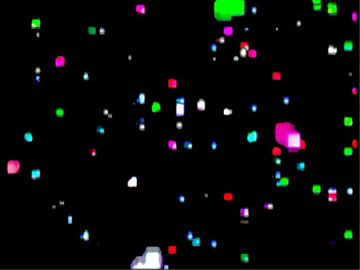
Vetoed UN resolutions hand-inscribed onto DV tape using a magnetic quill. Reinterpreted by the digital apparatus, these marks reveal abstract, lawless sonic and visual explosions – a fluid display of synthetic aerial terror. The action alludes to the shared nature of entertainment and military technology in seeking perfect spectacle whilst shunning error or uncertainty. Compressed light and sound are unleashed in volatile glitches to commemorate the abandonment of conventions in both the digital medium and international law.
Dave Griffiths is a British artist working with film, video, animation and sound. His film works dwell on the physical and fictive borders of media spaces and forms. He combines a rigorous attention to barely perceptible matter in moving images with an aesthetic study of their dramatic potential. Along with political and historical asides, the work is filtered through the languages and strategies of cinema and media art to attempt an ironic critique of our social bond with visual technologies.
Michael Robinson, All Through the Night, 2007, 6’ (US)

All Through the Night is described by Michael Robinson as a “charred visitation with an icy language of control; there is no room for love”. In this 4 minute digital video sequence, Robinson recontextualizes appropriated animation footage. In doing so, he successfully merges video effects into textures and glacial landscapes and creates his own kind of melancholic magic.
Since the year 2000, Michael Robinson has created a body of film, video and photography work exploring the poetics of loss and the dangers of mediated experience. His work has screened in both solo and group shows at a variety of festivals, cinematheques and galleries including the International Film Festival Rotterdam, The New York Film Festival, The Times BFI London Film Festival, Media City, Anthology Film Archives, Viennale, Cinematexas, The Wexner Center for the Arts, ICA London, Impakt, The Yerba Buena Center for the Arts, Chicago Filmmakers, PDX, and the San Francisco, Oberhausen, and Hong Kong International Film Festivals. Michael currently teaches filmmaking at Binghamton University.
Mary Helena Clark, And the Sun Flowers, 2008, 5′ (US)

‘Henry James had his figure in the carpet, Da Vinci found faces on the wall. Within this Baltimore wallpaper: a floral forest of hidden depth and concealment, the hues and fragrance of another era. Surface decoration holds permeable planes, inner passages. There emerges a hypnotic empyrean flower, a solar fossil a speaking anemone, of paper, of human muscle, of unknown origin, delivering an unreasonable message of rare tranquillity.’ (Mark McElhatten)
Mary Helena Clark is a Baltimore-based filmmaker. Her short films have been shown at numerous international festivals including Rotterdam and Views of the Avant-Garde (New York).
Rebecca Baron & Doug Goodwin, Lossless #5, 2008, 3′ (US)
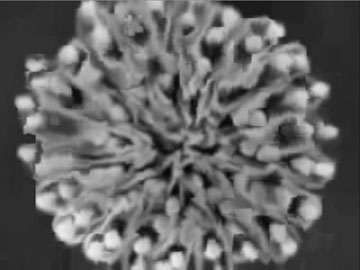
Lossless is a series of works that looks at the dematerialization of film into bits, exposing the residual effects of the process that makes file sharing possible. Baron and Goodwin used several methods to alter these works, either interrupting the data streaming by removing basic information holding together the digital format or comparing 35 mm to DVD and examining the difference between each frame. The project considers the impact of the digital age on filmmaking and film watching, the materiality and demateriality of film as an artistic medium, as well as the social aspects of how the online community functions and the audience for such obscure films.
The films of Rebecca Baron (US, 1972) have screened widely in international film festivals and media venues including Documenta 12, Rotterdam, Viennale, Oberhausen, Cinémathèque Française, Anthology Film Archive and the Whitney Museum of American Art’s 2000 Biennial. Baron teaches documentary and experimental film at the California Institute of the Arts.
Douglas Goodwin is an artist and writer. His work investigates the mechanisms by which language and technology mediate the area between perception and reality. His work has shown in Los Angeles, Frankfurt, Boston, Seattle, San Francisco, and Denver.
Martijn Hendriks, The Birds without the birds (excerpt), 2007-ongoing, 3’ (NL)
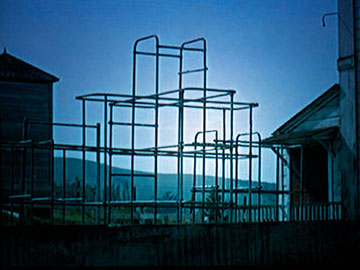
Martijn Hendriks is fascinated by the potential of negation and the conditions under which a non-productive gestures becomes productive. By drawing the attention to what remains after the objects of our attention have been erased, sabotaged of shown to contradict themselves, he questions our relation to images and the expectations of visibility and availability. In recent video work such as This is where we’ll do it, a series of manipulated You Tube clips, or The Birds without the birds, in which he uses fragments from Hitchcock’s The Birds, the absence of essential elements from well known images brings unexpected notions to the foreground.
Martijn Hendriks’s (NL, 1973) videos, sculptures and installations are often the results of seemingly unproductive acts like displacements, theft, jokes, withholding things, disruptions, obstructions, overdoing things, and attempts at clearly impossible tasks. The work he shows rarely documents those actions directly. Rather, it is what is left over from them or produced by those acts. His work has been exhibited internationally in galleries, centres for contemporary art and museums of modern art, and in 2008 he received the international Kraft Prize for New Media for his ongoing work The Birds without the birds. He lives and works in Amsterdam.
Nicolas Provost, Papillon D’Amour, 2003, 03’30” (BE)
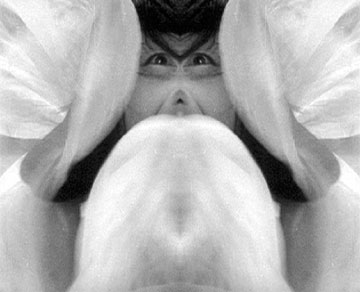
By subjecting fragments from the Akira Kurosawa’s film Rashomon to a mirror effect, Provost creates a hallucinatory scene of a woman’s reverse chrysalis into an imploding butterfly. This physical audiovisual experience produces skewed reflections upon Love, its lyrical monstrosities, and a wounded act of disappearance.
The work of Nicolas Provost (BE, 1969) is a reflection on the grammar of cinema and the relation between visual art and the cinematic experience. His short films have been awarded at prestigious festivals worldwide and he’s now busy with his first long feature film. He lives and works in Brussels.
Stewart Smith, Jed’s Other Poem, 2005, 3’ (US)

Stewart Smith programmed JED’S OTHER POEM, a music video for a Grandaddy song, in Applesoft II on a 1979 Apple ][+ with 48K of RAM. Seriously. Jeddy-3, a humanoid robot built from spare parts, is a recurring character in Grandaddy’s 2000 album “The Sophtware Slump”. According to Grandaddy, before Jed’s system crashed he wrote poems. Poems for no one.
Stewart Smith is an artist-programmer in New York City. He earned his MFA from Yale University in 2008 and operates Stewdio, a consultancy that approaches art and software through the lens of graphic design. Stewart has also taught introductory Web design at Yale and occasionally advises organizations exploring new interactive technologies and visualization techniques.